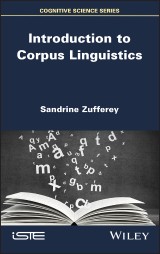Details

Introduction to Corpus Linguistics
1. Aufl.
|
139,99 € |
|
| Verlag: | Wiley |
| Format: | |
| Veröffentl.: | 22.09.2020 |
| ISBN/EAN: | 9781119779711 |
| Sprache: | englisch |
| Anzahl Seiten: | 288 |
DRM-geschütztes eBook, Sie benötigen z.B. Adobe Digital Editions und eine Adobe ID zum Lesen.
Beschreibungen
Over the past decades, the use of quantitative methods has become almost generalized in all domains of linguistics. However, using these methods requires a thorough understanding of the principles underlying them. Introduction to quantitative methods in linguistics aims at providing students with an up-to-date and accessible guide to both corpus linguistics and experimental linguistics. The objectives are to help students developing critical thinking about the way these methods are used in the literature and helping them to devise their own research projects using quantitative data analysis.
<p>Preface ix</p> <p><b>Chapter 1. How to Define Corpus Linguistics </b><b>1</b></p> <p>1.1. Defining elements 1</p> <p>1.2. Empiricism versus rationalism in linguistics 4</p> <p>1.3. Chomsky’s arguments against empiricism in linguistics 5</p> <p>1.4. Corpus linguistics and computer tools 8</p> <p>1.5. Quantitative versus qualitative methods 11</p> <p>1.6. Differences between corpus linguistics and experimental linguistics 14</p> <p>1.7. Different types of corpora 16</p> <p>1.8. Conclusion 19</p> <p>1.9. Revision questions and answer key 20</p> <p>1.9.1. Questions 20</p> <p>1.9.2. Answer key 21</p> <p>1.10. Further reading 23</p> <p><b>Chapter 2. How to Use Corpora in Theoretical Linguistics </b><b>25</b></p> <p>2.1. Phonetics and phonology 25</p> <p>2.2. Morphology 29</p> <p>2.3. Syntax 32</p> <p>2.4. Lexicon 35</p> <p>2.5. Discourse analysis 38</p> <p>2.6. Pragmatics 41</p> <p>2.7. Sociolinguistics 43</p> <p>2.8. Diachronic linguistics 46</p> <p>2.9. Conclusion 48</p> <p>2.10. Revision questions and answer key 49</p> <p>2.10.1. Questions 49</p> <p>2.10.2. Answer key 50</p> <p>2.11. Further reading 52</p> <p><b>Chapter 3. How to Use Corpora in Applied Linguistics </b><b>53</b></p> <p>3.1. Language acquisition 53</p> <p>3.2. Language impairments 58</p> <p>3.3. Second language acquisition 61</p> <p>3.4. Language teaching 64</p> <p>3.5. Lexicography 68</p> <p>3.6. Stylistics 72</p> <p>3.7. Legal linguistics 74</p> <p>3.8. Conclusion 77</p> <p>3.9. Revision questions and answer key 77</p> <p>3.9.1. Questions 77</p> <p>3.9.2. Answer key 78</p> <p>3.10. Further reading 80</p> <p><b>Chapter 4. How to Use Multilingual Corpora </b><b>83</b></p> <p>4.1. Comparable corpora and parallel corpora 83</p> <p>4.2. Looking for a <i>tertium comparationis </i>87</p> <p>4.3. Translations as a discursive genre 90</p> <p>4.4. Multilingual corpora and contrastive linguistics 92</p> <p>4.5. Parallel corpora and translation studies 97</p> <p>4.6. Parallel corpora and bilingual dictionaries 100</p> <p>4.7. Conclusion 102</p> <p>4.8. Revision questions and answer key 102</p> <p>4.8.1. Questions 102</p> <p>4.8.2. Answer key 103</p> <p>4.9. Further reading 105</p> <p><b>Chapter 5. How to Find and Analyze Corpora in French </b><b>107</b></p> <p>5.1. Corpora formats and their availability 107</p> <p>5.2. Reference corpora 110</p> <p>5.3. Written French corpora 111</p> <p>5.4. Spoken French corpora 114</p> <p>5.5. Children and learner corpora 116</p> <p>5.6. Multilingual corpora including French 119</p> <p>5.7. Corpus consultation tools 123</p> <p>5.7.1. Concordancers 123</p> <p>5.7.2. Focus on the AntConc concordancer 126</p> <p>5.7.3. Focus on the CLAN concordancer 128</p> <p>5.8. Conclusion 129</p> <p>5.9. Revision questions and answer key 130</p> <p>5.9.1. Questions 130</p> <p>5.9.2. Answer key 131</p> <p>5.10. Further reading 136</p> <p><b>Chapter 6. How to Build a Corpus </b><b>137</b></p> <p>6.1. Before deciding to build a corpus 137</p> <p>6.2. Establishing the size and representativeness of data 139</p> <p>6.3. Choosing language samples 143</p> <p>6.4. Preparing and coding corpus files 147</p> <p>6.5. Recording and transcribing spoken data 152</p> <p>6.6. Ethical and legal issues 154</p> <p>6.7. Conclusion 157</p> <p>6.8. Revision questions and answer key 157</p> <p>6.8.1. Questions 157</p> <p>6.8.2. Answer key 158</p> <p>6.9. Further reading 162</p> <p><b>Chapter 7. How to Annotate a Corpus </b><b>163</b></p> <p>7.1. Corpus annotations 163</p> <p>7.2. Different types of annotations 166</p> <p>7.3. Standardization of annotation schemes 170</p> <p>7.4. The stages of the annotation process 171</p> <p>7.5. Annotation tools 177</p> <p>7.6. Measuring the quality and reliability of an annotation 180</p> <p>7.7. Sharing your annotations 184</p> <p>7.8. Conclusion 186</p> <p>7.9. Revision questions and answer key 186</p> <p>7.9.1. Questions 186</p> <p>7.9.2. Answer key 187</p> <p>7.10. Further reading 193</p> <p><b>Chapter 8. How to Analyze Corpus Data </b><b>195</b></p> <p>8.1. Descriptive statistics for corpus data 195</p> <p>8.2. Measuring the lexical richness of a corpus 200</p> <p>8.3. Measuring lexical dispersion in a corpus 202</p> <p>8.4. Basics of inferential statistics 204</p> <p>8.5. Typical variables in corpus studies 207</p> <p>8.6. Measuring the differences between categories 210</p> <p>8.7. Conclusion 219</p> <p>8.8. Revision questions and answer key 220</p> <p>8.8.1. Questions 220</p> <p>8.8.2. Answer key 222</p> <p>8.9. Further reading 226</p> <p>Conclusion: The Stages for Carrying Out a Corpus Study 227</p> <p>References 233</p> <p>Index 255</p>
Sandrine Zufferey: full professor of French Linguistics Christelle Gillioz: lecturer in French Linguistics, postdoctoral researcher in psycholinguistics
Diese Produkte könnten Sie auch interessieren:

Cognitive-Behavioural Therapy for ADHD in Adolescents and Adults

von: Susan Young, Jessica Bramham

41,99 €

Cognitive-Behavioural Therapy for ADHD in Adolescents and Adults

von: Susan Young, Jessica Bramham

41,99 €

Offenders with Developmental Disabilities

von: William R. Lindsay, John L. Taylor, Peter Sturmey

53,99 €













